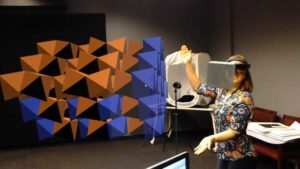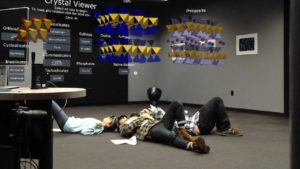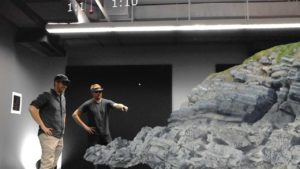Washington University Teachers use Augmented Reality in the Classroom
When it comes to teaching, sometimes out-of-the-box methods are the most effective ones. Teachers at the Fossett Laboratory for Virtual Planetary Exploration at Washington University are using augmented reality to help students in the Earth and Planetary Sciences department study complex geology in the classroom.
The lab, with the help of research scientist Martin Pratt and graduate student Kelsey Prissel, is developing new ways to use augmented reality to help students look at rock formations and minerals. Pratt and Prissel are experts in HoloLens, a mixed reality headset that allows students to visualize different 3D models and interact with them. The technique has been proven to increase student engagement, Prissel said.
“You’re telling students: Hey, we’re going to look at these holograms, and they think it’s exciting. For the mineral labs, students really liked being able to see the structures magnified and interact with them. They can explore the visualizations as a group and answer lab questions. They really enjoyed that experience,” Prissel said.

Augmented reality differs from virtual reality because it’s more interactive. For example, if you consult Google Earth and go into street view, you’d be experiencing virtual reality. Augmented reality, or what you experience through a HoloLens headset, allows you to walk around and interact with the models of the street.
So far, Pratt, Prissel, and other teachers in the department have used the technology in two ways. The first is for field outcrops. It’s important for geology students to look at rock outcrops in the field to see how they formed. Pratt and Prissel created models of the outcrops so students can don a HoloLens headset and explore them in the classroom. “It’s a virtual fieldtrip,” Prissel said. “They make sketches and practice observing rocks in the field.”
Prissel and Pratt presented their experience using this technique at the recent Focus on Teaching and Technology (FTTC) conference in St. Louis. Students at Washington University went to a specific location and looked at rocks where they naturally occur, all without leaving the classroom, the pair said during their presentation.

The second use of augmented reality technology in the department is for a lab activity involving mineral structures. Two undergraduate classes used the technology to see the building blocks of minerals and other small features of the structures. Traditionally labs do this work with 3D models or 2D graphic representations, so it was fun to present students with a new way of looking at these structures, Prissel said.
Even though the technology has been successful so far, it comes with some limitations. Sometimes it’s important for students to look at the same models at the same time, but the models they’re viewing through the headset could be in different locations. Pratt has overcome this issue by creating technology that syncs everyone’s headsets so they can see the same thing.
“Shared experiences are very important especially if we’re trying to simulate a field experience,” Pratt said. “Collaborative learning with virtual objects is something we’re very interested to include in our applications.”
Another challenge of using augmented reality in teaching is scale. Some students mentioned that it was hard to see an outcrop model all at once. The model is deployed in a room so the walls limit how far you can walk back and look at rock formations. In response to this feedback, Pratt coded a feature that allows the user to zoom in and out of the model and “teleport” around it.
“As a final feature, we added the ability to remove all the restrictions on position and scale and have the user freely manipulate the model to whatever size they want. You can now have a model of the surface of Mars next to you on your desk!” Pratt said.

Challenges aside, the technology is gaining ground at Washington University. Augmented reality runs through smartphone apps and the Department of Earth and Planetary Sciences has created one called GeoXplorer. It draws on geological datasets to present users with 3D models. The app has been downloaded by at least 100 people to date, Prissel said.
In the future, apps could be distributed on a larger scale so more institutions can use augmented reality activities in their classroom. Pratt is also advocating for a database of 3D models so scientists can share models with one another.
“People are identifying diverse needs to visualize with the HoloLens,” Prissel said. “Hopefully by making the resources available, people can get the app can use it in their classroom. I foresee us and others coming up with more lab activities using this technology.”



